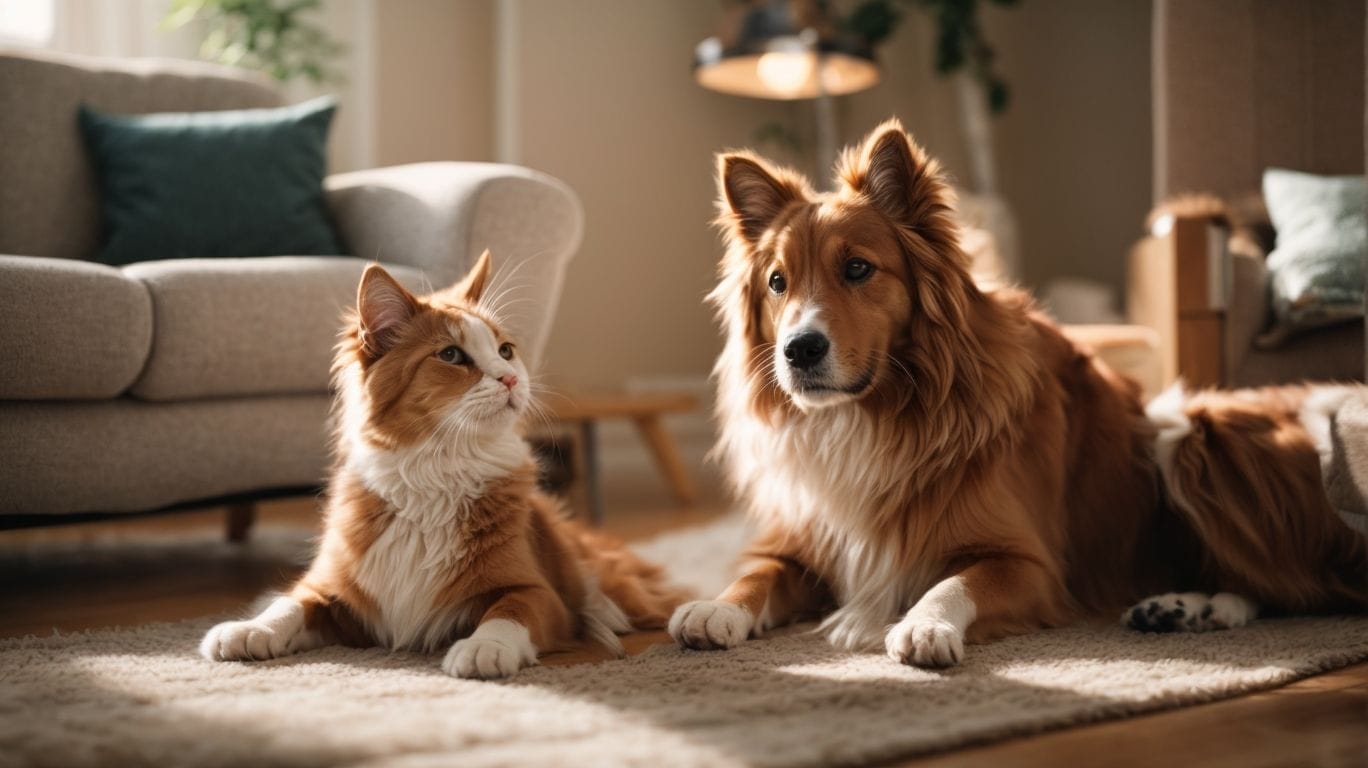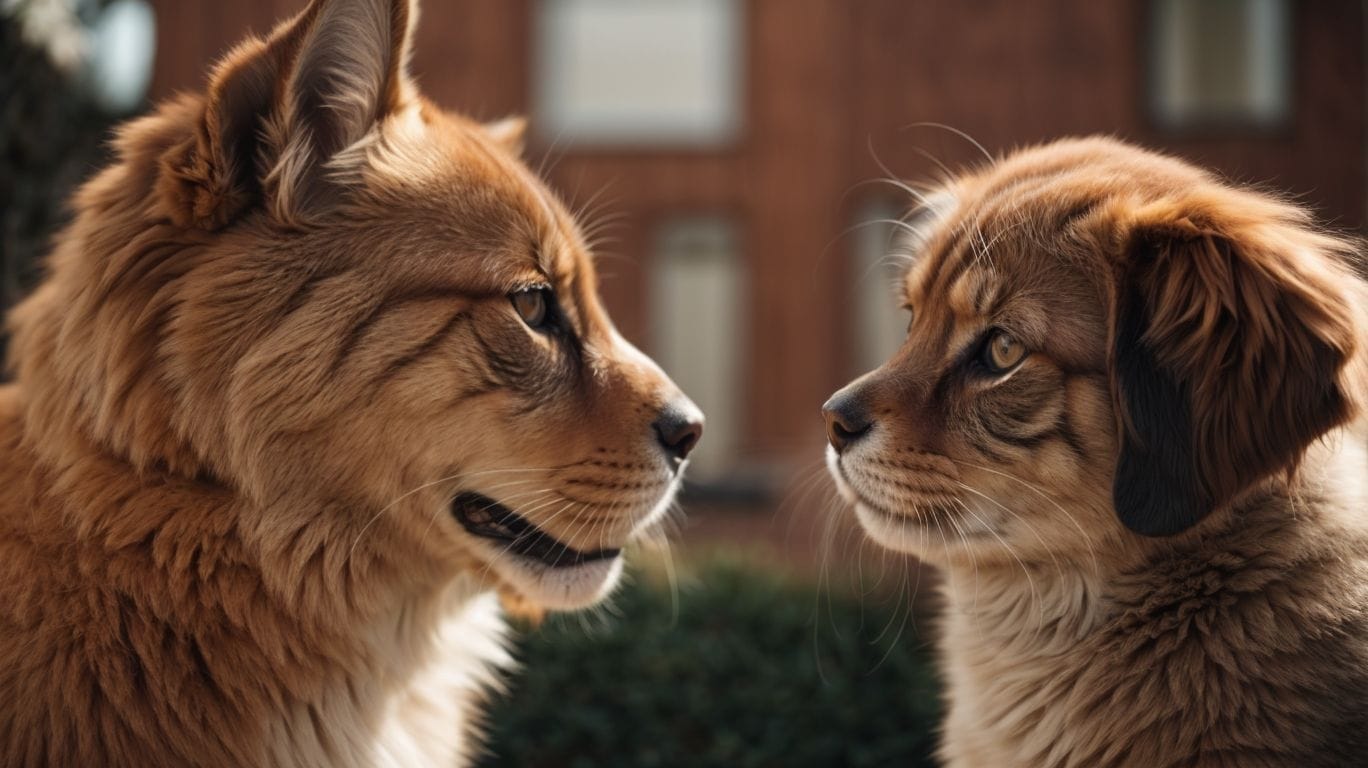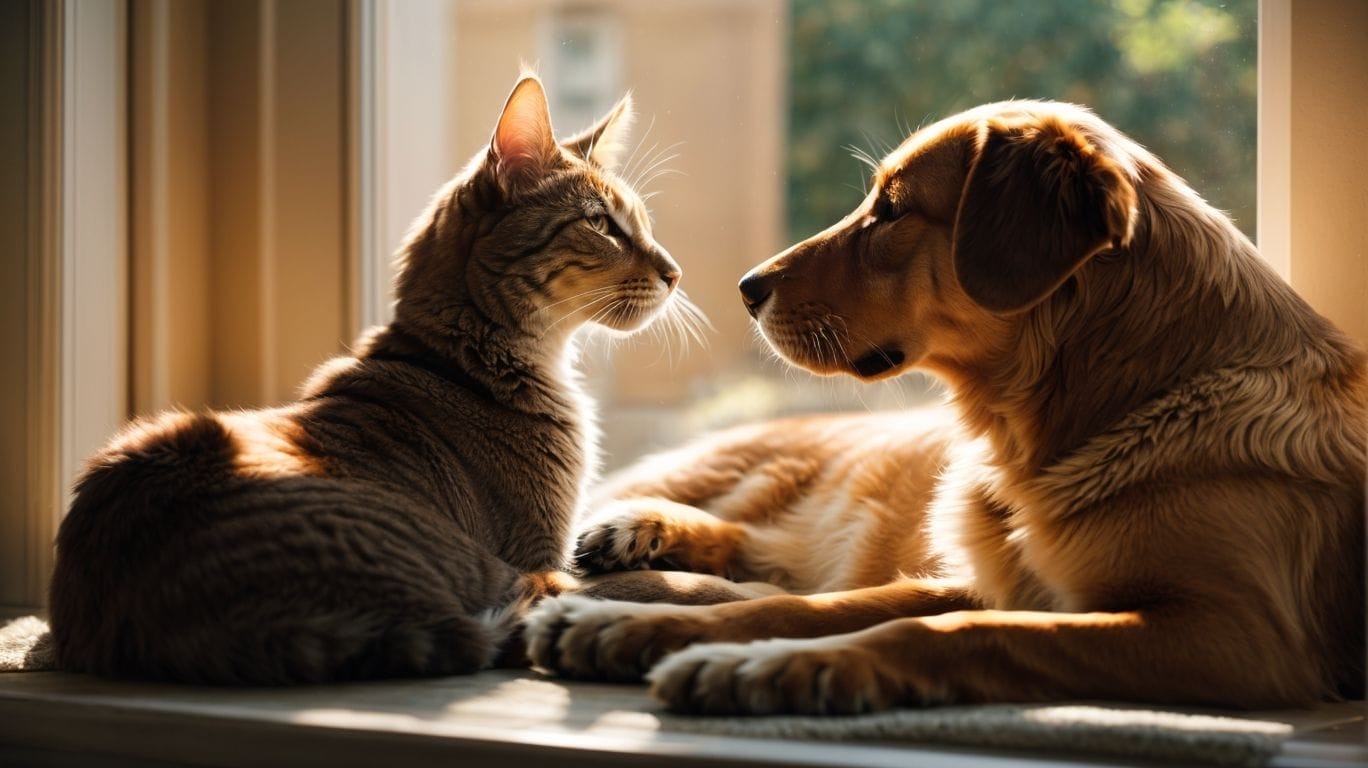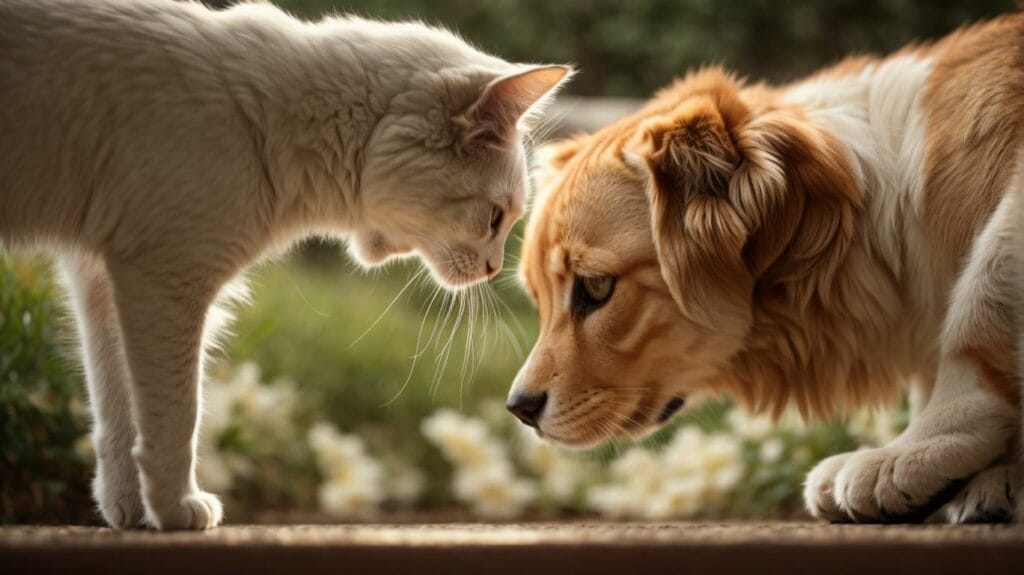Do Dogs and Cats Get Along? This is a common question among pet owners and animal lovers. The dynamics between dogs and cats can vary greatly depending on various factors. Understanding these factors can help determine whether dogs and cats can coexist harmoniously.
The compatibility of dogs and cats is influenced by several factors, including their personalities, previous experiences with other animals, and their socialization history. An article published by the American Society for the Prevention of Cruelty to Animals (ASPCA) provides valuable insights into this topic.
When introducing dogs and cats, it is important to follow a slow and controlled approach. This involves carefully managing their initial interactions and allowing them to acclimate to each other gradually. Creating separate spaces for each pet can also help them feel safe and secure during the introduction. Positive reinforcement techniques, such as treats and praise, can also help foster positive associations between the two animals.
To ensure a successful relationship between dogs and cats, it is essential to understand their unique behaviors. Dogs are naturally social animals with a pack mentality, while cats are more independent and territorial. Being aware of their distinct behavioral traits can help pet owners better manage their interactions and address any potential conflicts that may arise.
Certain signs indicate a successful dog and cat relationship, such as mutual curiosity, tolerance, and the ability to coexist in the same space peacefully. However, not all dogs and cats will develop a harmonious bond. In such cases, it is crucial to take appropriate measures to ensure the safety and well-being of both pets.
By following these guidelines and being observant of their behavior, pet owners can promote a positive relationship between their dogs and cats. However, should issues persist, seeking guidance from a professional animal behaviorist or trainer is advisable to address any underlying concerns and improve the overall compatibility between dogs and cats.
Key takeaway:
- Can Dogs and Cats Live Together? Dogs and cats can live together harmoniously, but compatibility depends on various factors such as their personalities, breed, and early socialization experiences.
- How to Introduce Dogs and Cats: Introduce dogs and cats gradually by creating separate spaces, using positive reinforcement, and allowing controlled interactions. Patience and monitoring are key to a successful introduction.
- Signs of a Successful Dog and Cat Relationship: Signs of a successful dog and cat relationship include mutual tolerance, relaxed body language, and playful interactions. Both animals should feel safe and comfortable in each other’s presence.
Do Dogs and Cats Get Along?

Photo Credits: Petnarnia.Com by Sean Flores
Regarding the age-old question of whether dogs and cats get along, Do Dogs and Cats Get Along? The answer can vary depending on the individual animals and their personalities. Here are a few factors to consider:
- Introductions: Proper introductions between dogs and cats are crucial, allowing them to get acquainted in a controlled environment.
- Temperament: The temperament and socialization of the dog and the cat play a big role in their compatibility.
- Training: It’s important to train the dog and the cat to respect each other’s boundaries and house rules.
- Supervision: Supervise their interactions until you are confident they can be left alone together.
- Patience: Give them time to adjust to each other’s presence and establish their relationship.
Can Dogs and Cats Live Together?
Living harmoniously with both dogs and cats is possible, but it requires careful consideration and management. Can Dogs and Cats Live Together? Here are some factors to consider when determining if dogs and cats can live together:
- Temperament: Assess the personality traits of both the dog and cat. Some dogs and cats may naturally have a more amicable disposition, making them more likely to coexist.
- Early socialization: Dogs and cats exposed to each other from a young age are more likely to develop a positive relationship.
- Size and energy level: Dogs that are smaller and have a calm temperament may be a better match for cats.
- Training and obedience: Dogs should have a solid foundation in training and be able to follow commands, especially when interacting with cats.
- Supervision and gradual introductions: Initially, dogs and cats should be kept in separate spaces and slowly introduced using positive reinforcement techniques.
By considering these factors and taking appropriate measures, dogs and cats can coexist peacefully in the same household.
Factors Affecting the Compatibility of Dogs and Cats
Factors Affecting the Compatibility of Dogs and Cats
Various factors can influence the compatibility of dogs and cats living together. These factors include the temperament of the individual animals, their socialization history, and the introduction process.
Here is a
summarizing these factors: Remember, every pet is unique, and while these factors can increase the likelihood of compatibility, it’s essential to monitor their interactions and provide each animal with their own safe space. How to Introduce Dogs and Cats Photo Credits: Petnarnia.Com by Douglas CarterIntroducing dogs and cats can be a delicate process. Still, with the right approach, it can pave the way for harmonious coexistence. In this section, we’ll explore effective strategies to bring these furry companions together. From slow and controlled introductions to creating separate spaces, we’ll uncover techniques that promote a positive atmosphere for both dogs and cats. So, let’s dive into the art of facilitating their budding relationship with love, patience, and a sprinkle of positive reinforcement! Slow and Controlled IntroductionA slow and controlled introduction is essential when introducing dogs and cats. This important process is key in helping them adapt to each other’s presence and reduces potential stress. Here is a step-by-step guide on how to do it effectively:
Photo Credits: Petnarnia.Com by Douglas CarterIntroducing dogs and cats can be a delicate process. Still, with the right approach, it can pave the way for harmonious coexistence. In this section, we’ll explore effective strategies to bring these furry companions together. From slow and controlled introductions to creating separate spaces, we’ll uncover techniques that promote a positive atmosphere for both dogs and cats. So, let’s dive into the art of facilitating their budding relationship with love, patience, and a sprinkle of positive reinforcement! Slow and Controlled IntroductionA slow and controlled introduction is essential when introducing dogs and cats. This important process is key in helping them adapt to each other’s presence and reduces potential stress. Here is a step-by-step guide on how to do it effectively:
1. Begin with scent exchange: Allow them to sniff each other’s bedding or toys.
2. Gradually expose them visually: Utilize baby gates or crates to keep them separated while allowing visual contact.
3. Organize face-to-face meetings with control: Use leashes and reinforce calm behavior, gradually increasing their time together.
4. Stay present during their interactions: Supervise their interactions and be prepared to intervene if necessary.
5. Gradually integrate them: Increase their time together over several weeks, always focusing on their safety above all else. Let me share a true story: An acquaintance of mine introduced her dog and cat using this method. After a deliberate and controlled introduction, they now cuddle and play together. It is truly heartwarming to witness their bond flourishing. Creating Separate SpacesCreating separate spaces is of utmost importance when introducing dogs and cats to each other. This process ensures a smooth transition and reduces the likelihood of conflicts arising.
To begin, it is recommended to provide separate rooms or designated areas for each pet. This creates a sense of security and helps establish boundaries. To visually acquaint the pets without direct contact, employing baby gates or pet barriers within the shared living spaces is suggested.
Regarding individual necessities, it is essential to provide each pet with its food, water bowls, litter boxes, toys, and resting areas. This ensures they feel comfortable and have their own space.
Gradually, access to shared spaces should be introduced on a rotational basis. This allows for supervised interactions between the pets while gradually increasing their time together.
As the pets interact, it is important to observe their behavior closely. Positive reinforcement should be given when they display calm and friendly interactions, encouraging good behavior.
Remember, when creating separate spaces, it is crucial to maintain patience. Rushing the introduction process can inadvertently result in stress and hostility between the pets. Using Positive ReinforcementUsing positive reinforcement is an effective way to foster a harmonious relationship between dogs and cats. Here are some strategies for utilizing positive reinforcement techniques:
- Reward desired behavior: Whenever your dog and cat interact calmly or show signs of tolerance, praise and reward them with treats or affection.
- Training: Employ positive reinforcement techniques, such as clicker training, to teach your dog and cat basic commands and tricks.
- Environmental enrichment: Create a stimulating environment with toys, scratching posts, and hiding spots, ensuring both pets have designated spaces.
- Gradual introductions: Take your time and slowly expose your dog and cat to each other using scent exchanges and supervised meetings while consistently rewarding them for displaying calm behavior.
By using positive reinforcement, you can cultivate a positive association between your dog and cat, ultimately leading to a successful and peaceful coexistence. In a heartwarming example of using positive reinforcement, a dog and cat named Bella and Max initially showed wariness towards each other. However, their owner took a gradual approach, introducing them and providing rewards and praise for their calm behavior. With consistent training and environmental enrichment, Bella and Max developed a strong bond and now delight in playing and cuddling together. This success story beautifully showcases the power of positive reinforcement in creating and nurturing positive relationships between dogs and cats. Understanding Canine and Feline Behavior Photo Credits: Petnarnia.Com by Patrick MooreUnraveling the intricacies of canine and feline behavior, let’s dive into the world of understanding our furry companions. From decoding dog behavior to deciphering cat behavior, we’ll embark on a journey to uncover the fascinating dynamics between these two species. Discover the many quirks, instincts, and communication styles that make dogs and cats such unique and captivating creatures in our lives. So, get ready to explore the captivating world of our four-legged friends!
Photo Credits: Petnarnia.Com by Patrick MooreUnraveling the intricacies of canine and feline behavior, let’s dive into the world of understanding our furry companions. From decoding dog behavior to deciphering cat behavior, we’ll embark on a journey to uncover the fascinating dynamics between these two species. Discover the many quirks, instincts, and communication styles that make dogs and cats such unique and captivating creatures in our lives. So, get ready to explore the captivating world of our four-legged friends!
Dog BehaviorDog Behavior is an essential aspect to consider when evaluating the compatibility of dogs and cats. Dogs, being pack animals, have an innate instinct to establish a hierarchy. Their means of communication encompass body language, vocalization, and scent marking. It is crucial to carefully observe and interpret their behaviors to guarantee a successful introduction to cats. For instance, a wagging tail can indicate excitement or friendliness, while raised hackles may signify fear or aggression. By providing proper socialization and training, dogs can display appropriate behavior towards cats, thereby enhancing the likelihood of a harmonious relationship between the two.Cat BehaviorUnderstanding cat behavior is essential when considering introducing dogs and cats. Cat behavior is characterized by their independent nature and territorial tendencies. Cats may exhibit behaviors such as hissing, scratching, or hiding when they feel threatened or stressed. To ensure the well-being of cats, it is crucial to create a secure and tranquil environment by providing hiding spots, vertical spaces, and separate areas. Employing positive reinforcement and implementing gradual introductions can aid in making cats feel more at ease around dogs. It’s also important to observe their body language, looking for signs of relaxation and playful behavior, as these indicate a successful dog and cat relationship. If dogs and cats do not seem to be getting along, seeking professional help from a trainer or behaviorist is strongly advised.Signs of a Successful Dog and Cat Relationship Photo Credits: Petnarnia.Com by Ethan LopezCreating a successful dog and cat relationship requires patience, careful introductions, and understanding their body language. Here are signs of a successful dog and cat relationship:
Photo Credits: Petnarnia.Com by Ethan LopezCreating a successful dog and cat relationship requires patience, careful introductions, and understanding their body language. Here are signs of a successful dog and cat relationship:
- Playfulness: If they engage in gentle play and take turns chasing each other, it suggests a positive dynamic.
- Relaxed body language: Both animals should appear calm and relaxed in each other’s presence, with no signs of fear or aggression.
- Shared space: When they comfortably share the same space without tension or territorial behaviors, it indicates a healthy relationship.
- Grooming: Mutual grooming, such as a dog licking a cat’s head, demonstrates trust and affection.
- Sleeping together: If they choose to sleep near each other or cuddle, it signifies a bond of companionship.
What to Do if Dogs and Cats Don’t Get Along Photo Credits: Petnarnia.Com by Edward BrownIf dogs and cats don’t get along, here is what to do:1. Gradual introduction: Allow them to get used to each other’s scent by swapping bedding or toys.2. Separate spaces: Give each pet their own designated area with food, water, and a litter box.3. Supervised interactions: When they are ready, supervise short and controlled interactions between the pets.4. Positive reinforcement: Reward calm and friendly behavior from both pets with treats and praise.Remember, every pet is unique, so be patient and consult a professional if needed. With time and effort, dogs and cats can learn to coexist peacefully.
Photo Credits: Petnarnia.Com by Edward BrownIf dogs and cats don’t get along, here is what to do:1. Gradual introduction: Allow them to get used to each other’s scent by swapping bedding or toys.2. Separate spaces: Give each pet their own designated area with food, water, and a litter box.3. Supervised interactions: When they are ready, supervise short and controlled interactions between the pets.4. Positive reinforcement: Reward calm and friendly behavior from both pets with treats and praise.Remember, every pet is unique, so be patient and consult a professional if needed. With time and effort, dogs and cats can learn to coexist peacefully.
Some Facts About Do Dogs and Cats Get Along?
- ✅ Dogs and cats can live together peacefully with proper introduction and socialization. (Source: Our Team)
- ✅ It is best to socialize dogs and cats early in life to minimize stress and avoid conflicts. (Source: Our Team)
- ✅ Bringing a cat into a dog’s home that is not used to cats can trigger chasing behavior in the dog. (Source: Our Team)
- ✅ Proper socialization and training are important for a hunting dog to coexist with a skittish cat. (Source: Our Team)
- ✅ Cats and dogs can share resources and live together in an amicable way. (Source: Our Team)
| Factors | Description |
|---|---|
| Temperament | Dogs and cats with a calm and friendly disposition are more likely to get along. Aggressive or fearful animals may have difficulty cohabiting. |
| Socialization | Animals that have been exposed to and positively interacted with each other from a young age have a higher chance of compatibility. |
| Introduction Process | A slow and controlled introduction, allowing the animals to gradually get used to each other’s scent and presence, can greatly improve their chances of getting along. Using positive reinforcement during this process can also help establish positive associations. |
| Do Dogs and Cats Get Along? | Do Dogs and Cats Get Along? |


